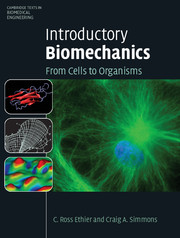Book contents
- Frontmatter
- Contents
- About the cover
- Preface
- 1 Introduction
- 2 Cellular biomechanics
- 3 Hemodynamics
- 4 The circulatory system
- 5 The interstitium
- 6 Ocular biomechanics
- 7 The respiratory system
- 8 Muscles and movement
- 9 Skeletal biomechanics
- 10 Terrestrial locomotion
- Appendix: The electrocardiogram
- Index
- Plate section
- References
Appendix: The electrocardiogram
Published online by Cambridge University Press: 05 June 2012
- Frontmatter
- Contents
- About the cover
- Preface
- 1 Introduction
- 2 Cellular biomechanics
- 3 Hemodynamics
- 4 The circulatory system
- 5 The interstitium
- 6 Ocular biomechanics
- 7 The respiratory system
- 8 Muscles and movement
- 9 Skeletal biomechanics
- 10 Terrestrial locomotion
- Appendix: The electrocardiogram
- Index
- Plate section
- References
Summary
The electrocardiogram (ECG) is important for several reasons. First and foremost, it provides information about the activity of the heart muscle, and it is therefore an essential non-invasive clinical tool used to diagnose certain cardiac abnormalities. From the biomechanical viewpoint, it provides a convenient reference signal for time-varying quantities in the vascular tree, specifically pulsatile flow, pressure, and arterial pulsation. Here we briefly describe the main features of the ECG.
The contraction of cardiac muscle is controlled by an intrinsically generated electrical signal. In other words, the heart is responsible for its own stimulation, although the rate of stimulation can be modulated by external factors. In order to understand the behavior of this pacemaker system, we must first study several basic facts about the propagation of electric signals in excitable cells, a category that includes nerve and muscle cells. The general aspects of the description that follows are true for all excitable cells; however, the details are specific to cardiac muscle cells.
Normally, the cell's interior is held at a negative electrical potential measured with respect to the surrounding extracellular fluid. This small potential difference (the resting potential, equal to approximately −90 mV) exists because of a difference in ionic composition across the cell's membrane (Table A.1). This difference in composition is actively maintained by pumps residing in the cell's membrane that transport ions against their concentration gradient.
- Type
- Chapter
- Information
- Introductory BiomechanicsFrom Cells to Organisms, pp. 489 - 497Publisher: Cambridge University PressPrint publication year: 2007



